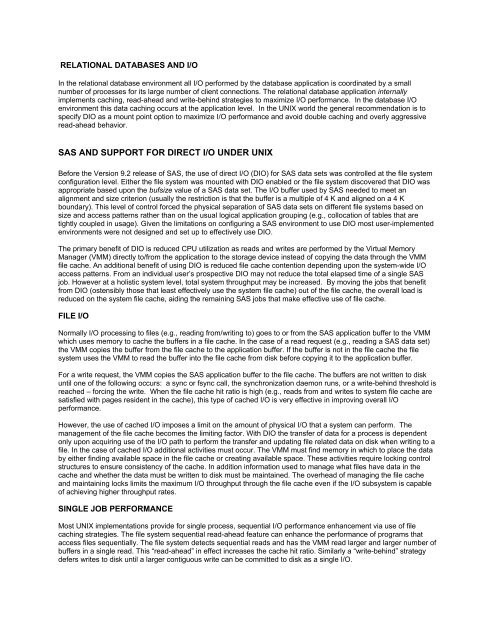Improving SAS® I/O Throughput by Avoiding the Operating System ...
Improving SAS® I/O Throughput by Avoiding the Operating System ...
Improving SAS® I/O Throughput by Avoiding the Operating System ...
You also want an ePaper? Increase the reach of your titles
YUMPU automatically turns print PDFs into web optimized ePapers that Google loves.
RELATIONAL DATABASES AND I/O<br />
In <strong>the</strong> relational database environment all I/O performed <strong>by</strong> <strong>the</strong> database application is coordinated <strong>by</strong> a small<br />
number of processes for its large number of client connections. The relational database application internally<br />
implements caching, read-ahead and write-behind strategies to maximize I/O performance. In <strong>the</strong> database I/O<br />
environment this data caching occurs at <strong>the</strong> application level. In <strong>the</strong> UNIX world <strong>the</strong> general recommendation is to<br />
specify DIO as a mount point option to maximize I/O performance and avoid double caching and overly aggressive<br />
read-ahead behavior.<br />
SAS AND SUPPORT FOR DIRECT I/O UNDER UNIX<br />
Before <strong>the</strong> Version 9.2 release of SAS, <strong>the</strong> use of direct I/O (DIO) for SAS data sets was controlled at <strong>the</strong> file system<br />
configuration level. Ei<strong>the</strong>r <strong>the</strong> file system was mounted with DIO enabled or <strong>the</strong> file system discovered that DIO was<br />
appropriate based upon <strong>the</strong> bufsize value of a SAS data set. The I/O buffer used <strong>by</strong> SAS needed to meet an<br />
alignment and size criterion (usually <strong>the</strong> restriction is that <strong>the</strong> buffer is a multiple of 4 K and aligned on a 4 K<br />
boundary). This level of control forced <strong>the</strong> physical separation of SAS data sets on different file systems based on<br />
size and access patterns ra<strong>the</strong>r than on <strong>the</strong> usual logical application grouping (e.g., collocation of tables that are<br />
tightly coupled in usage). Given <strong>the</strong> limitations on configuring a SAS environment to use DIO most user-implemented<br />
environments were not designed and set up to effectively use DIO.<br />
The primary benefit of DIO is reduced CPU utilization as reads and writes are performed <strong>by</strong> <strong>the</strong> Virtual Memory<br />
Manager (VMM) directly to/from <strong>the</strong> application to <strong>the</strong> storage device instead of copying <strong>the</strong> data through <strong>the</strong> VMM<br />
file cache. An additional benefit of using DIO is reduced file cache contention depending upon <strong>the</strong> system-wide I/O<br />
access patterns. From an individual user’s prospective DIO may not reduce <strong>the</strong> total elapsed time of a single SAS<br />
job. However at a holistic system level, total system throughput may be increased. By moving <strong>the</strong> jobs that benefit<br />
from DIO (ostensibly those that least effectively use <strong>the</strong> system file cache) out of <strong>the</strong> file cache, <strong>the</strong> overall load is<br />
reduced on <strong>the</strong> system file cache, aiding <strong>the</strong> remaining SAS jobs that make effective use of file cache.<br />
FILE I/O<br />
Normally I/O processing to files (e.g., reading from/writing to) goes to or from <strong>the</strong> SAS application buffer to <strong>the</strong> VMM<br />
which uses memory to cache <strong>the</strong> buffers in a file cache. In <strong>the</strong> case of a read request (e.g., reading a SAS data set)<br />
<strong>the</strong> VMM copies <strong>the</strong> buffer from <strong>the</strong> file cache to <strong>the</strong> application buffer. If <strong>the</strong> buffer is not in <strong>the</strong> file cache <strong>the</strong> file<br />
system uses <strong>the</strong> VMM to read <strong>the</strong> buffer into <strong>the</strong> file cache from disk before copying it to <strong>the</strong> application buffer.<br />
For a write request, <strong>the</strong> VMM copies <strong>the</strong> SAS application buffer to <strong>the</strong> file cache. The buffers are not written to disk<br />
until one of <strong>the</strong> following occurs: a sync or fsync call, <strong>the</strong> synchronization daemon runs, or a write-behind threshold is<br />
reached – forcing <strong>the</strong> write. When <strong>the</strong> file cache hit ratio is high (e.g., reads from and writes to system file cache are<br />
satisfied with pages resident in <strong>the</strong> cache), this type of cached I/O is very effective in improving overall I/O<br />
performance.<br />
However, <strong>the</strong> use of cached I/O imposes a limit on <strong>the</strong> amount of physical I/O that a system can perform. The<br />
management of <strong>the</strong> file cache becomes <strong>the</strong> limiting factor. With DIO <strong>the</strong> transfer of data for a process is dependent<br />
only upon acquiring use of <strong>the</strong> I/O path to perform <strong>the</strong> transfer and updating file related data on disk when writing to a<br />
file. In <strong>the</strong> case of cached I/O additional activities must occur. The VMM must find memory in which to place <strong>the</strong> data<br />
<strong>by</strong> ei<strong>the</strong>r finding available space in <strong>the</strong> file cache or creating available space. These activities require locking control<br />
structures to ensure consistency of <strong>the</strong> cache. In addition information used to manage what files have data in <strong>the</strong><br />
cache and whe<strong>the</strong>r <strong>the</strong> data must be written to disk must be maintained. The overhead of managing <strong>the</strong> file cache<br />
and maintaining locks limits <strong>the</strong> maximum I/O throughput through <strong>the</strong> file cache even if <strong>the</strong> I/O subsystem is capable<br />
of achieving higher throughput rates.<br />
SINGLE JOB PERFORMANCE<br />
Most UNIX implementations provide for single process, sequential I/O performance enhancement via use of file<br />
caching strategies. The file system sequential read-ahead feature can enhance <strong>the</strong> performance of programs that<br />
access files sequentially. The file system detects sequential reads and has <strong>the</strong> VMM read larger and larger number of<br />
buffers in a single read. This “read-ahead” in effect increases <strong>the</strong> cache hit ratio. Similarly a “write-behind” strategy<br />
defers writes to disk until a larger contiguous write can be committed to disk as a single I/O.
















